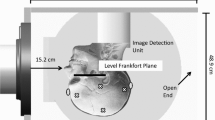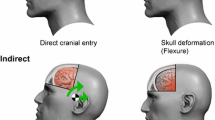Abstract
The manner in which energy from an explosion is transmitted into the brain is currently a highly debated topic within the blast injury community. This study was conducted to investigate the injury biomechanics causing blast-related neurotrauma in the rat. Biomechanical responses of the rat head under shock wave loading were measured using strain gauges on the skull surface and a fiber optic pressure sensor placed within the cortex. MicroCT imaging techniques were applied to quantify skull bone thickness. The strain gauge results indicated that the response of the rat skull is dependent on the intensity of the incident shock wave; greater intensity shock waves cause greater deflections of the skull. The intracranial pressure (ICP) sensors indicated that the peak pressure developed within the brain was greater than the peak side-on external pressure and correlated with surface strain. The bone plates between the lambda, bregma, and midline sutures are probable regions for the greatest flexure to occur. The data provides evidence that skull flexure is a likely candidate for the development of ICP gradients within the rat brain. This dependency of transmitted stress on particular skull dynamics for a given species should be considered by those investigating blast-related neurotrauma using animal models.







Similar content being viewed by others
References
Battacharjee, Y. Shell shock revisited: solving the puzzle of blast trauma. Science 319:406–408, 2008.
Bauman, R., G. Ling, L. Tong, A. Januszkiewicz, D. Agoston, N. Delanerolle, J. Kim, D. Ritzel, R. Bell, J. Ecklund, R. Armonda, F. Bandak, and S. Parks. An introductory characterization of combat casualty care relevant swine model of closed head injury resulting from exposure to explosive blast. J. Neurotrauma 26:841–876, 2009.
Cernak, I. Penetrating and blast injury. Restor. Neurol. Neurosci. 23:139–143, 2005.
Chafi, M., G. Karami, and M. Ziejewski. Biomechanical assessment of brain dynamic responses due to blast pressure waves. Ann. Biomed. Eng. 38:490–504, 2010.
Chavko, M., W. Koller, W. Prusaczyk, and R. McCarron. Measurement of blast wave by a miniature fiber optic pressure transducer in the rat brain. J. Neurosci. Methods 159:277–281, 2007.
Clemedson, C., and C. Criborn. Mechanical response of different parts of a living body to a high explosive shock wave impact. Am. J. Physiol. 181:471–476, 1955.
Courtney, M., and A. Courtney. Working toward exposure thresholds for blast-induced traumatic brain injury: thoracic and acceleration mechanisms. Neuroimage 54:S55–S61, 2011.
Finkel, M. The neurological consequences of explosives. J. Neurol. Sci. 249:63–67, 2006.
Henshall, B. Shock tube–versatile tool of aerodynamic research. J. Royal Aeronaut. Soc. 58:541–546, 1954.
Hicks, R., S. Fertig, R. Desrocher, W. Koroshetz, and J. Pancrazio. Neurological effects of blast injury. J. Trauma 68:1257–1263, 2010.
Hoge, C., D. McGurk, J. Thomas, A. Cox, C. Engel, and C. Castro. Mild traumatic brain injury in U.S. Soldiers returning from Iraq. N. Engl. J. Med. 358:453–463, 2008.
Kluger, Y., A. Nimrod, P. Biderman, A. Mayo, and P. Sorkin. The quinary pattern of blast injury. Am. J. Disaster Med. 2:21–25, 2007.
Lechner, R., G. Achatz, T. Hauer, H. Palm, A. Lieber, and C. Willy. Patterns and causes of injuries in a contemporary combat environment. Unfallchirurg 113:106–113, 2010.
Leonardi, A., C. Bir, D. Ritzel, and P. VandeVord. Intracranial pressure increases during exposure to a shock wave. J. Neurotrauma 28:85–94, 2011.
Ling, G., and J. Ecklund. Traumatic brain injury in modern war. Curr. Opin. Anaesthesiol. 24:124–130, 2011.
Luks, F. Blast injuries—and the pivotal role of trauma surgeons. Acta Chir. Belg. 110:517–520, 2010.
Moss, W., M. King, and E. Blackman. Skull flexure from blast waves: a mechanism for brain injury with implications for helmet design. Phys. Rev. Lett. 103:108702, 2009.
Mott, F. On the effects of high explosives upon the central nervous system. Lancet 187:331–338, 1916.
Risling, M. Blast induced brain injuries—a grand challenge in TBI research. Front. Neurol. 8:1, 2010.
Romba, J., and P. Martin. The propagation of air shock waves on a biophysical model. US Army Ordinance Technical Memorandum, pp. 17–61, 1961.
Stuhmiller, J., K. Ho, M. VanderVorst, K. Dodd, T. Fitzpatrick, and M. Mayorga. A model of blast overpressure injury to the lung. J. Biomech. 29:227–234, 1996.
Taylor, P., and C. Ford. Simulation of blast-induced early time intracranial wave physics leading to traumatic brain injury. J. Biomech. Eng. 131:061007, 2009.
Acknowledgments
We would like to thank the WSU Bioengineering Center staff and students for assisting with this project. We would also like thank Dr. Amanda Esquivel for obtaining the CT images. This project was partially funded by DOD Award Number W81XWH-08-2-0207 and the Thomas J. Rumble Fellowship.
Author information
Authors and Affiliations
Corresponding author
Additional information
Associate Editor Stefan M Duma oversaw the review of this article.
Rights and permissions
About this article
Cite this article
Bolander, R., Mathie, B., Bir, C. et al. Skull Flexure as a Contributing Factor in the Mechanism of Injury in the Rat when Exposed to a Shock Wave. Ann Biomed Eng 39, 2550–2559 (2011). https://doi.org/10.1007/s10439-011-0343-0
Received:
Accepted:
Published:
Issue Date:
DOI: https://doi.org/10.1007/s10439-011-0343-0




